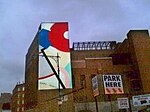Eyebeam (organization)
Eyebeam is a not-for-profit art and technology center in New York City, founded by John Seward Johnson III with co-founders David S. Johnson and Roderic R. Richardson. Originally conceived as a digital effects and coding atelier and center for youth education, Eyebeam has become a center for the research, development, and curation of new media works of art and open source technology. Eyebeam annually hosts up to 20 residents and co-produces youth educational programs, exhibitions, performances, symposia, workshops, hackathons and other events with these residents as well as with partner organizations. Projects developed at Eyebeam have received awards and recognition including Webby Awards, Guggenheim Fellowships, and the Prix Ars Electronica.
Excerpt from the Wikipedia article Eyebeam (organization) (License: CC BY-SA 3.0, Authors).Eyebeam (organization)
West 21st Street, New York Manhattan
Geographical coordinates (GPS) Address Nearby Places Show on map
Geographical coordinates (GPS)
| Latitude | Longitude |
|---|---|
| N 40.747105555556 ° | E -74.007122222222 ° |
Address
West 21st Street 542
10011 New York, Manhattan
New York, United States
Open on Google Maps




